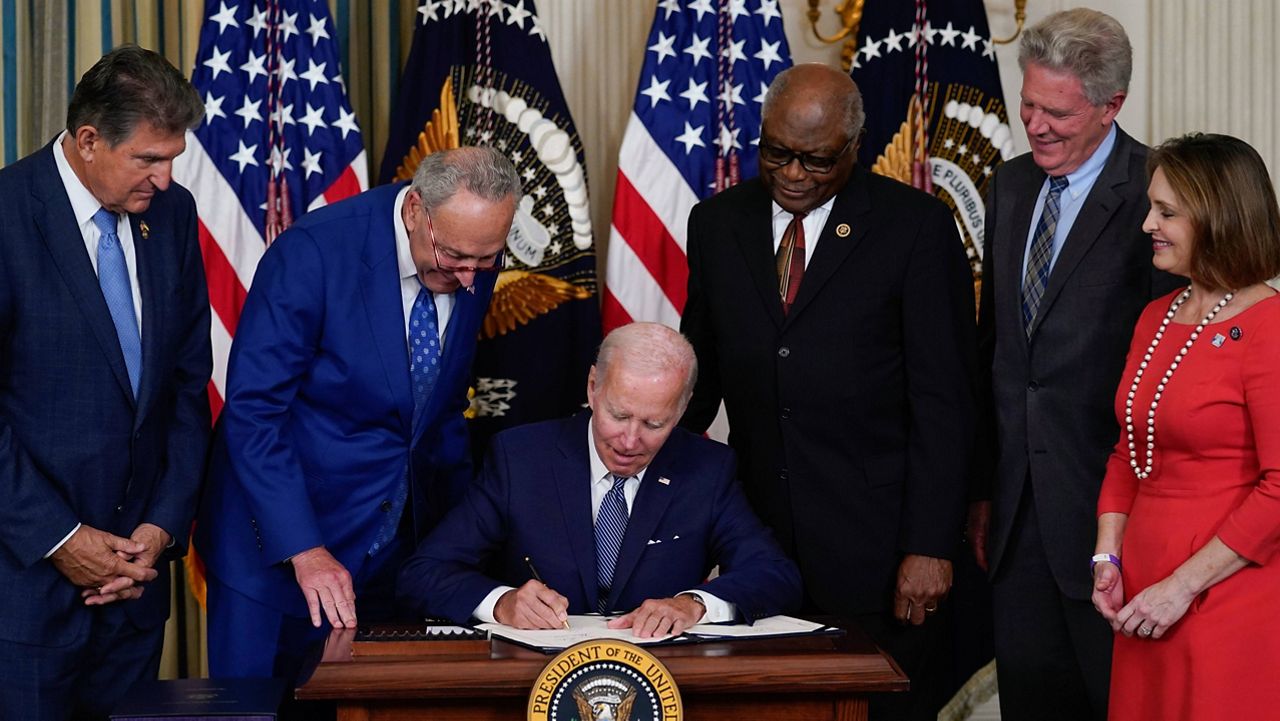LOS ANGELES — As President Biden signed the massive Inflation Reduction Act into law Tuesday, a bipartisan coalition that has spent years advocating for many of its environmental provisions dissected what it all means. At its core, the new law is a major milestone in the country’s transition from an economy long driven by fossil fuels to one that will be dominated by minerals such as lithium, nickel and aluminum. But it is also about national security.
“You can’t separate economic and national security," former Director of National Intelligence Admiral Dennis Blair said during a web briefing on behalf of the nonprofit bipartisan group he now chairs. Called SAFE, Securing America’s Future Energy was founded in 2006 when military and business leaders joined forces to accelerate the country’s adoption of more resilient and sustainable energy and transportation systems.
Electric vehicles, Blair said, are “the most practical and near-term way to shrink the role of oil in our transportation sector and therefore the dead hand of these swing-producing countries over American policy.”
More recently, he said, SAFE has identified other economic sectors where American supply chains are vulnerable to economic pressure from other countries, especially China, which holds sway over raw materials processing for electric vehicle batteries, renewable energy technologies and semiconductors. Other important, yet susceptible, economic systems include international freight transportation and the nation’s electrical grid.
“All of these issues are tied together, and they have to be improved together if we are to improve the economic security of this country and therefore the national security,” Blair said. “That’s been our common theme: to reduce and eliminate American and allied vulnerability to pressure from countries that wish us ill and don’t share our values.”
The IRA is one of three “very important pieces of economic and national security legislation that have been passed within the last nine months,” Blair said, noting the Bipartisan Infrastructure Law President Biden signed last November and the CHIPS and Science Act he signed just last week.
While the Bipartisan Infrastructure Law provides $65 billion to transition the nation’s energy grid to renewables and improve the country’s ports, airports, rail system and roads, the IRA takes a “minerals-to-markets approach,” said SAFE Founder and President Robbie Diamond. “It’s the first serious demand and supply side policy. It’s not piecemeal.”
With $370 billion earmarked to combat climate change, the IRA pursues both sides of the puzzle in equal measure, with generous incentives to spur the transition to clean energy and electric vehicles while simultaneously addressing where their raw ingredients are sourced, what countries are processing them and how they’re assembled into usable products.
Specifically, the act calls for the installation of 950 million solar panels, 120,000 wind turbines and 2,300 grid-scale battery plants by 2030. It also provides $14,000 in direct consumer rebates for families to buy heat pumps and other energy-efficient home appliances and $7,500 in tax credits for buyers of new electric vehicles.
But pulling that off “will take time and decades,” Diamond said. “We need these policies to exist. And then we need to implement, implement, implement. When it comes to the supply chain manufacturing capacity and all these pieces in this bill, it will be difficult.”
While the Inflation Reduction Act extends the $7,500 federal tax credit for new electric vehicles, it comes with multiple hurdles. Starting next year, the Inflation Reduction Act requires that 40% of the minerals and 50% of the battery components used to make EVs come from North America or a country with which the U.S. has a free trade agreement.
As of December 2023, no battery components can come from a foreign entity of concern. The same requirement applies to minerals at the end of December 2024.
The key choke point is critical minerals processing. China currently controls between 50 and 100% of the processing capabilities for the minerals critical for a transition to clean energy and transportation, according to SAFE. Because the U.S. does not have a free trade agreement with China, manufacturers would need to source EV component materials from inside the U.S. or with trading partners such as Australia, Canada, Chile and Korea.
“It was important that there were sourcing provisions tied to the tax credit to make sure that our auto sector couldn’t be used as a political pawn in the future,” said SAFE’s Center for Critical Minerals Strategy Vice President, Abigail Wulf. “Unfortunately, our industries do not operate in a vacuum. Should anything happen between Washington and Beijing or anyplace else where we currently rely on these critical mineral supply chains, we’d be in a bit of a pickle.”
In 2019, the Trump administration devised a strategy for the U.S. Department of Interior to locate domestic supplies of critical minerals in an effort to reduce foreign reliance on the key ingredients for items like cellphones, computers and cars. Last year, the Biden administration bolstered that effort when it provided $75 million in funding for the U.S. Geological Survey to map critical minerals through the Bipartisan Infrastructure Law.
The IRA builds on some of the resiliency provisions established with last year’s Bipartisan Infrastructure Law, which will invest $14 billion to make the national power grid more secure and reliable. The Inflation Reduction Act adds another $9.7 billion to improve rural electrical systems, $2.9 billion to upgrade transmission lines and a tax credit for electric vehicle chargers with bidirectional capability that allow vehicles to send the energy stored in their batteries back to the power utility to help with grid reliability.
The act also includes $6 billion in grants for battery and minerals recycling, manufacturing and processing.
“We are transitioning from this fossil fuel-based economy to a minerals-based economy, and it’s not just going to be the minerals that are used to create our electric vehicle batteries,” Wulf said. “It will power all of our industries from our buildings to our water glasses. Just take a look around you. Anything that wasn’t grown was mined.”



